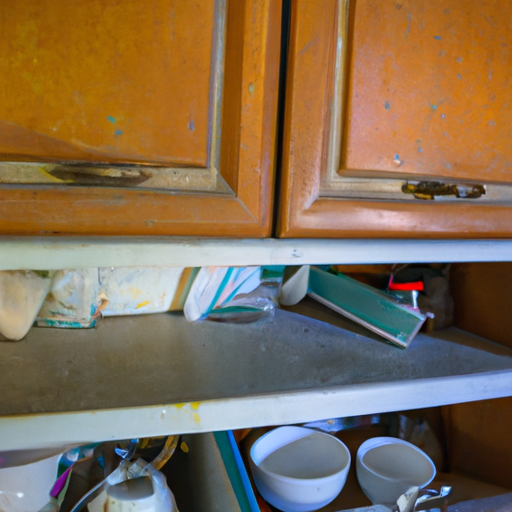Unlock the secrets to a spotless kitchen with our Ultimate Guide to Cleaning Kitchen Cabinets and Drawers. This comprehensive guide is packed full of practical tips, advice and step-by-step instructions on how to clean, maintain, and extend the life of your kitchen cabinets and drawers. Whether you're dealing with stubborn stains, grease, or just everyday dust and dirt, we've got you covered!
Why is it Essential to Regularly Clean Your Kitchen Cabinets and Drawers?
Regularly cleaning your kitchen cabinets and drawers is essential for maintaining a clean and healthy kitchen environment. Over time, these areas can accumulate dirt, grease, and food particles, creating a breeding ground for bacteria and germs. Cleaning them regularly helps to prevent the spread of harmful microorganisms and ensures that your kitchen remains a safe space for food preparation and storage.
Furthermore, regular cleaning extends the lifespan of your cabinets and drawers. The accumulation of dirt and grease can cause damage to the surfaces, leading to discoloration, stains, and even structural issues. By regularly cleaning and maintaining them, you can prevent these problems and ensure that your cabinets and drawers remain in good condition for years to come.
Cleaning your kitchen cabinets and drawers also improves the overall appearance of your kitchen. Over time, the build-up of grime and grease can make your cabinets and drawers look dull and unappealing. Regular cleaning helps to restore their original shine and beauty, making your kitchen look more inviting and aesthetically pleasing.
In addition, regular cleaning allows you to organize your kitchen more efficiently. When cabinets and drawers are cluttered with dirt and debris, it becomes challenging to find and access the items you need. By regularly cleaning and organizing them, you can create a more functional and efficient kitchen space, saving you time and frustration in the long run.
A dirty kitchen cabinet before cleaning
"The dirtier, the harder" – Understanding Stubborn Stains and How to Fight Them
Stubborn stains can be a real headache when it comes to cleaning kitchen cabinets and drawers. These stains can range from grease splatters to dried-on food residue, and they can be quite challenging to remove. The key to tackling stubborn stains is understanding their nature and using the right techniques and products to fight them.
One common type of stubborn stain in the kitchen is grease. Grease stains can build up over time, especially in areas near the stove or oven. To combat grease stains, start by using a degreasing agent or a mixture of warm water and dish soap. Apply the solution to the stain, let it sit for a few minutes, and then gently scrub with a soft cloth or sponge. For tougher grease stains, you may need to use a stronger degreaser or a paste made of baking soda and water.
Another common stubborn stain is dried-on food residue. This can happen when spills or splatters are not immediately cleaned up. To remove dried-on food stains, start by moistening the area with warm water. Then, sprinkle baking soda or a mixture of baking soda and water onto the stain. Let it sit for a few minutes to loosen the residue, and then scrub gently with a sponge or brush. Rinse with warm water and dry thoroughly.
For stubborn stains that refuse to budge, you may need to use more potent cleaning agents such as vinegar or hydrogen peroxide. These can be effective in breaking down tough stains, but it's important to test them on a small, inconspicuous area first to ensure they don't damage the surface of your cabinets or drawers.
Ready, Set, Clean! – A Step-by-Step Guide to Cleaning your Cabinetry
Cleaning your kitchen cabinets and drawers can seem like a daunting task, but with a step-by-step guide, you'll have them looking spotless in no time. Start by removing all items from your cabinets and drawers, taking the opportunity to declutter and organize as you go. Use a microfiber cloth or a soft sponge to wipe down the surfaces, making sure to reach the corners and crevices. For stubborn stains, follow the techniques mentioned earlier, using appropriate cleaning agents. Once the surfaces are clean, don't forget to wipe down the handles and knobs as well.
Next, tackle the inside of your cabinets and drawers. Start by vacuuming or sweeping out any crumbs or debris. Then, use warm, soapy water or a mild cleaning solution to wipe down the shelves and drawers. Pay special attention to any spills or stains, using the appropriate techniques to remove them. Once everything is clean and dry, you can line your shelves and drawers with shelf liners for added protection and easy cleaning in the future.
After cleaning the surfaces and interiors, it's time to put everything back in an organized manner. Group similar items together and consider using storage containers or drawer organizers to maximize space and keep things tidy. Take this opportunity to also check for expired or unused items and dispose of them properly.
Illustration of the cleaning process with a focus on scrubbing and rinsing
Is there a Secret to Keeping Your Cabinets and Drawers Clean Longer?
Proper maintenance and a few simple strategies can help you keep your kitchen cabinets and drawers clean for a longer period of time. Here are some secrets to help you maintain the cleanliness and freshness of your cabinetry.
- 1. Regular Cleaning Routine:
Establishing a regular cleaning routine is key to keeping your cabinets and drawers clean longer. Set aside a specific day or time each week to wipe down the surfaces and remove any dust or debris. By incorporating this into your routine, you'll prevent dirt and grime from building up and becoming more difficult to clean later on. - 2. Avoid Excessive Moisture:
Moisture can be the enemy of clean cabinets and drawers. Avoid leaving wet or damp items inside your cabinets, as this can lead to mold and mildew growth. Additionally, be cautious when cleaning around sinks or dishwashers to prevent excessive moisture from seeping into the cabinetry. If you encounter any spills or moisture, make sure to wipe it up immediately to prevent damage. - 3. Use Cabinet Protectors:
Protecting your cabinets and drawers can go a long way in keeping them clean and extending their lifespan. Consider using cabinet protectors, such as adhesive bumpers or rubber feet, to prevent scratches or damage caused by items being placed on or moved around the surfaces. These protectors can also help reduce the chances of spills or stains by providing a barrier between the surface and the items stored inside.
Cleaning Kitchen Cabinets and Drawers:
| Step | Product | Time | Frequency |
|---|---|---|---|
| Clean interior surfaces with a mild all-purpose cleaner | Mild all-purpose cleaner | 15 minutes | Weekly |
| Wipe down cabinet exteriors with a damp cloth | Damp cloth | 10 minutes | Daily |
| Remove drawer liners and scrub with warm soapy water | Warm soapy water | 10 minutes | Monthly |
| Polish cabinet exteriors with a wood polish | Wood polish | 15 minutes | Every 3 Months |
With the right knowledge and a bit of elbow grease, keeping your kitchen cabinets and drawers in pristine condition can be a breeze. Our Ultimate Guide to Cleaning Kitchen Cabinets and Drawers provides you with the tools you need to tackle any cleaning challenge. So roll up your sleeves and start cleaning – your kitchen will thank you for it!



